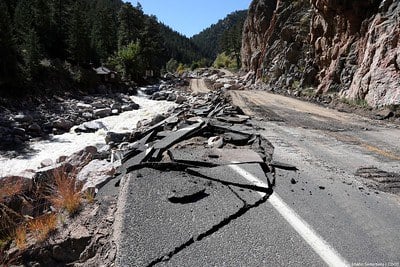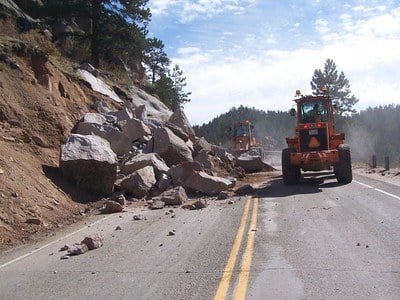Risk and Resilience Program
What is Resilience?
The State of Colorado defines resilience as “the ability of communities to rebound, positively adapt to, or thrive amidst changing conditions or challenges—including human-caused and natural disasters—and to maintain quality of life, healthy growth, durable systems, economic vitality, and conservation of resources for present and future generations.”
For transportation systems, resilience is the ability to keep our roads open and functional in the face of unexpected events and challenges. This can involve resilience of the assets themselves (e.g., the design and maintenance of bridges to withstand rare, yet catastrophic flood events), or adaptability of CDOT’s operations, maintenance, planning, etc., in the face of stressors and challenges. While the concept of resilience is not limited to physical threats, this is the main focus of resilience work in transportation.
View CDOT's Resilience Improvement Plan
Why being resilient matters
Resiliency became a priority for CDOT after a 2013 flood disaster along the Front Range resulted in nine deaths and caused over $4 billion in damage across the state. The event caused severe damage to roughly 500 miles of road and 50 bridges and required more than $750 million in emergency repairs to the state highway system alone.
Building on lessons learned from this and other events, CDOT has begun assessing its risk to threats to better prepare the transportation system in advance. Every day the system faces threats large and small – like floods, high winds, avalanches, rockfall, and other unexpected events. While many of these threats are unavoidable, their effects do not have to be catastrophic or cause extended road closures. Building resilience is like an insurance policy – by identifying a threat and implementing a mitigation measure, we can reduce the risk to our system in the future. Pro-active management of threats before they occur minimizes the resources needed to rebuild and restore service, minimizes the disruptions to people’s lives and to business activity, and lowers the cost to CDOT and the traveling public in the long run. National research on disaster damage and federal government spending suggests that every $1 spent on pre-disaster preparedness is worth $6 in terms of future damage it mitigates.
This is why CDOT is planning for these adverse events to ensure our transportation system is better able to withstand the impact of events and recover quickly when they happen – ensuring that the routes we use every day to access our homes, businesses, schools, and hospitals remain safe and accessible to all.
Resources
Risk and Resilience Suite of Tools
Contact [email protected] for access to any tools not available below.
- CDOT Asset Resiliency Mapping Application
- Asset Criticality Model for System Resilience
- 4R Framework for Identifying and Evaluating Resiliency in Transportation System Assets and Organizations
- Risk and Resilience Analysis Procedure: A Manual for Calculating Risk to CDOT Assets from Flooding Rockfall, and Fire Debris Flow
- Risk and Resilience Assessment Tool
- Risk and Resilience Project Scoring Tool
- CDOT Detour Identification Tool
CDOT’s Resilience Case Studies
CDOT has conducted a number of case studies focused on integrating resilience into agency operations. The findings are summarized in the following fact sheets:
- Asset Management Fact Sheet
- Project Prioritization Fact Sheet
- Project Scoping Fact Sheet
- Maintenance and Operations Fact Sheet
- Environmental Planning Fact Sheet
More Resources
Colorado’s approach to risk and resilience is further guided by the following:
- Resilience Improvement Plan 2025
- 2045 Statewide Plan Resilience Appendix
- Transportation Asset Management Plan
- Resiliency Planning Fact Sheet
- Esri Case Study: CDOT Building Back Better for a More Resilient Transportation System
- FHWA Case Study: CDOT Integrating Resilience into Agency Operations
- CDOT Climate Study: Changing Climate and Extreme Weather Impacts on Geohazards in Colorado
How is CDOT investing in resiliency?
Resilience Policy Directive
On Nov. 15, 2018, the Transportation Commission adopted Policy Directive (PD) 1905.0 “Building Resilience into Transportation Infrastructure and Operations”, which directs CDOT to support state resilience goals by incorporating resilience in strategic decisions about transportation assets and operations. The policy directive builds on the Department’s efforts since the 2013 floods to formalize and encourage future resilience activities at CDOT so that the department can manage risks and successfully adapt to future challenges.
The I-70 Risk and Resilience Pilot Study
The I-70 Risk and Resilience Pilot Study, completed in late 2017, builds on the work completed by CDOT in the wake of the catastrophic 2013 flood event. Please contact [email protected] for the report. It is a first-of-its kind approach, meant to address vulnerabilities in Colorado’s highway infrastructure by quantifying the risk and developing mitigation measures. 450 miles of I-70 from the Utah border in the west to the Kansas border in the east have been analyzed for the potential of future damage and closures from physical threats. The pilot considers multiple significant threats—ranging from avalanche to wildfire, as well as human-made threats, such as high vehicle bridge strikes, and provides a quantitative, data-driven approach to quantifying risk and calculating benefit cost of alternative mitigation measures.
